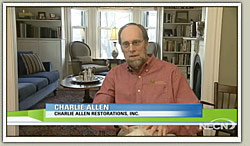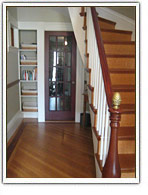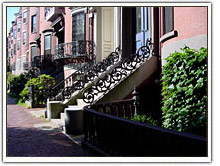| If the content or images below are not being displayed, please click here | ||||||||||||||||||||||||||||||||
 |
||||||||||||||||||||||||||||||||
Charlie Allen Renovations, Inc. |
91 River Street, Cambridge, MA 02139 |
||||||||||||||||||||||||||||||||
WHEN IS THE RIGHT TIME TO RENOVATE?
But a home maintenance to-do list is never finished, and in most cases, delaying a project only adds to the ultimate bottom line. Our lives don’t stop either: we add to our families, watch grown children move on, we grow older and anticipate the physical challenges that come with aging. Sometimes we simply learn that the existing layout of our home just doesn’t accommodate the ways we live our lives. With decades of experience with older homes, we thought it might be helpful to provide you with some general maintenance timeline suggestions, as well as a handy ROI chart to remind you that, in many cases, renovation is a good investment. MAINTENANCE:
Exterior Paint: Exterior painting is one of the most important home maintenance projects that can be done. Sometimes the paint and caulking is all that is stopping damage from the elements. It’s often neglected due to expense and homeowners are faced with the large investment of whole house re-painting. But if you have your house looked at every year and have the worn areas touched up and re-caulked and repaired a new whole house paint job should last 10-12 years. Electrical: Maintaining your electrical system may save you more than just cash — it can save your life. Many older homes feature a real bird’s nest of wiring running throughout; check yours carefully and make sure that the insulation hasn’t worn off—this poses a real danger. Knob and tube wiring can be a concern as well. Something else to consider are your outlets. Are they designed for two-prong plugs? You may want to replace these now: three-prong receptacles are grounded and much safer. Windows: Faulty windows have an immediate impact on your bottom line as they very quickly result in higher energy costs. You’ll know that your window needs to be replaced or refurbished when you feel cold winter air seeping inside. Windows that become coated with condensation, ice, or frost are also ready to be replaced or repaired. At Charlie Allen Renovations we believe that the best window is an original wood window that has been re-glazed, and repaired to proper working order. Paired with a storm window it is the best window package available. RENOVATION: With the economy in its current state, ROI (return-on-investment) figures are a good way to justify remodeling projects. All improvements are not equal—the following list details the top 5 home improvements most likely to recoup their costs upon the later sale of the house. Data comes from Remodeling magazine’s 2009-2010 survey, and figures are for the New England region only:
Of course, many of us are not thinking about resale value when considering renovations. If you’re simply interested in living more comfortably, there is no better investment than your home and we like to think the best time is always now. |
||||||||||||||||||||||||||||||||
|
||||||||||||||||||||||||||||||||
ASK MARK: Hardwood floors are a signature feature of period homes. This quarter, CAR project development manager Mark Philben talks about wood.
Q: Why were certain woods favored in the past? Q: Are the original woods still my best option or are there modern alternatives that would work better for me?
Q: What are the best finishes for a hardwood floor? |
||||||||||||||||||||||||||||||||
|
||||||||||||||||||||||||||||||||
WHAT IS A PERIOD HOME?
Brownstones are distinguished primarily by a brown sandstone exterior, which in many cases is the sole feature distinguishing them from the very similar rowhouse style. Both types of homes are common in urban settings, are generally three to four stories tall, and are built one after the other, often for the length of a city block. Because brown sandstone is a relatively ‘soft’ material, many brownstones feature elegant carved detailing. Bay windows are another common feature, punctuating many brownstone homes at the ‘parlor level,’ or the main floor off the front door, which is generally up one flight of exterior stairs from the street. The term ‘garden level’ usually refers to the level at or just below street level, sometimes accessed via an exterior door beneath the stairs and opening to a small courtyard area at the building’s rear. Already popular in London, the brownstone style became prominent in Boston in the mid-19th century, lending the city its European flavor. |
||||||||||||||||||||||||||||||||
|
||||||||||||||||||||||||||||||||
|
||||||||||||||||||||||||||||||||



 Q: Mark, are there easy ways to identify what type of wood flooring I have in my house?
Q: Mark, are there easy ways to identify what type of wood flooring I have in my house? Q: Are there warning signs that flooring needs to be replaced?
Q: Are there warning signs that flooring needs to be replaced? Here in the Boston area, the brownstone defines the city streetscape, particularly in neighborhoods like the Back Bay, South End, and Beacon Hill, where its design provides for a very efficient use of space.
Here in the Boston area, the brownstone defines the city streetscape, particularly in neighborhoods like the Back Bay, South End, and Beacon Hill, where its design provides for a very efficient use of space. Julie is the Director of Operations at Charlie Allen Renovations, and is usually the first person that a CAR client speaks to when they contact us. Since joining the firm in 1999, Julie has continuously sought new approaches toward making the CAR client experience a streamlined, happy and rewarding one, from initial consultation through the renovation and onward to the end of the project and beyond. Julie manages all client communications, oversees project budgets and subcontractors, and in general, anticipates, heads-off, and solves any bumps-in-the-road, changes-in-plans, or acts-of-God.
Julie is the Director of Operations at Charlie Allen Renovations, and is usually the first person that a CAR client speaks to when they contact us. Since joining the firm in 1999, Julie has continuously sought new approaches toward making the CAR client experience a streamlined, happy and rewarding one, from initial consultation through the renovation and onward to the end of the project and beyond. Julie manages all client communications, oversees project budgets and subcontractors, and in general, anticipates, heads-off, and solves any bumps-in-the-road, changes-in-plans, or acts-of-God.